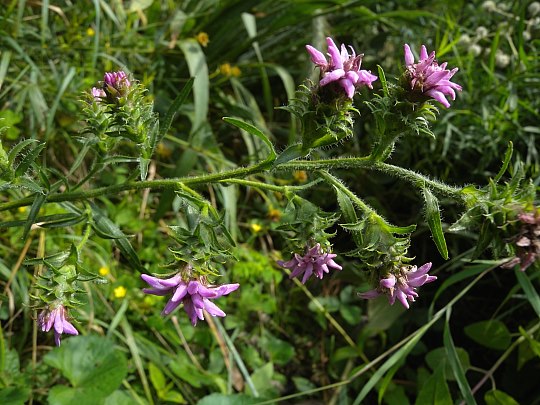Description: This perennial wildflower is 1–2½' tall and unbranched. The central stem is light green, slightly ridged, and glabrous to hairy. The alternate leaves occur along the entire length of the stem in widely spreading pseudo-whorls. The lowest leaves are 4-6" long and about ¼" across, becoming gradually smaller as they ascend the stem. The leaves are medium green, linear in shape, sessile, and glabrous to short-pubescent. Each stem terminates in a spike or narrow raceme of flowerheads about 2-8" long. These flowerheads are relatively few in number, and on rare occasions only a single flowerhead may be produced. Each flat-topped flowerhead is about ½–1" across, consisting of 15-45 pink disk florets above and overlapping floral bracts (phyllaries) below. There are no ray florets. Individual disk florets are tubular in shape; each of these florets has 5 recurved slender lobes at its apex. Each disk floret has a bifurcated style that is white to light pink; it is often strongly exerted and recurved.

The scaly bracts
are green, glabrous to hairy, and relatively large in size; they are
either straight and loosely arranged around the base of each
flowerhead, or they are strongly recurved. The bracts are lanceolate,
broadly lanceolate, or deltoid in shape and their tips are pointed,
rather than rounded. The flowerheads are either sessile (or nearly so),
or they can have peduncles up to 1¼" long. At the base of each peduncle
(or sessile flowerhead), there is a small leafy bract that is linear in
shape. The blooming period occurs from mid- to late summer and lasts
about 1 month. The flowerheads bloom from the top to the bottom. With
maturation, the disk florets are replaced by small achenes that are
bullet-shaped and pubescent; each achene has a tuft of feathery
bristles at its apex. The achenes are distributed by the wind to some
extent. The root system consists of a globoid corm with fibrous roots
below. Sometimes vegetative offsets are produced.
Cultivation:
The preference is full sun, dry-mesic to dry conditions, and a barren
soil containing rocky material or some sand.

Range & Habitat:
The native Scaly Blazingstar is occasional in southern Illinois and
absent
elsewhere in the state (see Distribution
Map). Habitats include hill prairies, limestone or sandstone
glades, ledges of sunny cliffs, openings in upland rocky woodlands, and
barren savannas. This wildflower is found in high quality natural
areas. Occasional wildfires are beneficial because the encroachment of
woody vegetation is reduced.
Faunal Assocations:
The flowerheads are cross-pollinated primarily by bumblebees,
butterflies, and skippers. In general, several insect species feed on Liatris
spp. (Blazingstars). These species include: the caterpillars
of Schinia sanguinea (Blazingstar Flower Moth),
which feed on the florets and developing seeds; the caterpillars of Papaipema
beeriana (Blazingstar Borer Moth) and Carmenta
anthracipennis (Liatris Borer Moth), which bore through the
stems; and the aphids Aphis laciniariae and Aphis
craccivora, which suck plant juices. The foliage and
flowerheads of Blazingstars are edible to many mammalian herbivores,
including cattle, horses, sheep, goats, deer, rabbits, and groundhogs.
Where these mammals are abundant, Blazingstar populations usually
decline.
Photographic Location:
The wildflower garden of the webmaster in Urbana, Illinois.
Comments:
Scaly Blazingstar is highly variable across its range and several
varieties have been described. Generally, all of these varieties have
relatively large floral bracts with pointed tips that are either
loosely arranged or recurved along the bottoms of the flowerheads.
However, there is considerable variability in the following
characteristics: 1) the size of individual flowerheads can be variable
with 15-45 (or more) disk florets, 2) the flowerheads can be sessile or
they can have short to medium-length peduncles, 3) the leaves and stems
can be glabrous to hairy, and 4) the floral bracts that define the base
of each flowerhead can be either straight or strongly recurved. Scaly
Blazingstar differs from other Liatris spp.
(Blazingstars) primarily by the characteristics of its scaly floral
bracts, which provide it with a rather odd appearance.